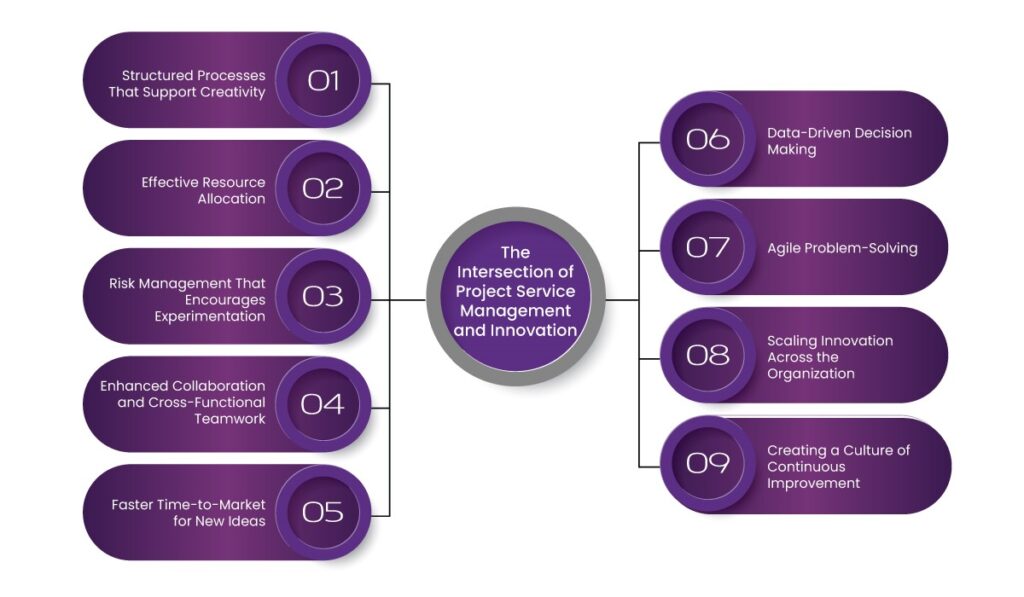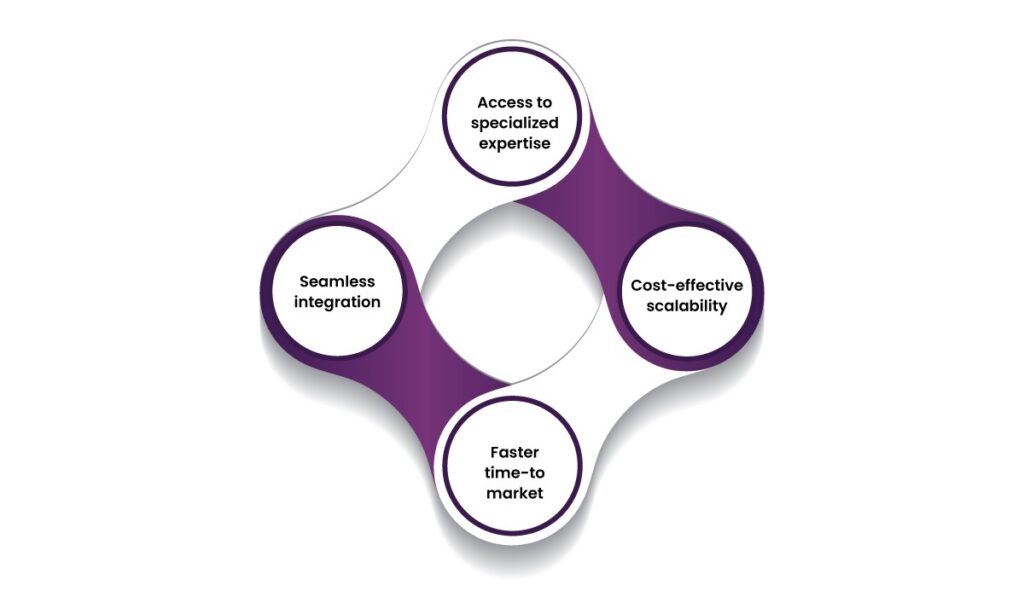Innovation isn’t just about having great ideas—it’s about bringing them to life. While creativity sparks the flame, structure, planning, and execution, keep it burning. That’s where project service management steps in. It turns visionary concepts into tangible outcomes by streamlining workflows, promoting collaboration, and minimizing risks. Today, companies that embrace structured project management don’t just keep up—they set the pace for the future.
Table of Contents
The Intersection of Project Service Management and Innovation
Project service management provides the framework for moving ideas from concept to completion. Here’s how:
1. Structured Processes That Support Creativity
Contrary to the belief that structure stifles creativity, it actually enables it. Project management methodologies like Agile, Scrum, and Lean encourage innovation while maintaining a clear roadmap. These frameworks help businesses experiment, iterate, and refine ideas while keeping projects on track.
For example, an agile-driven approach allows teams to break down complex projects into smaller, manageable tasks. This not only enhances productivity but also gives room for quick adjustments so teams can incorporate fresh ideas as they progress.
2. Effective Resource Allocation
Innovation doesn’t happen in a vacuum—it requires time, money, and talent. Therefore, one of the key functions of project service management is to optimize resource allocation. By identifying key stakeholders, setting realistic budgets, and allocating tasks effectively, project management services help organizations make the best use of their resources.
When businesses allocate resources efficiently, teams can focus on developing innovative solutions rather than dealing with bottlenecks. This approach leads to better project outcomes and reduces wastage of valuable assets.
3. Risk Management That Encourages Experimentation
Innovation often comes with an element of uncertainty. Without proper risk management, businesses may shy away from exploring new ideas due to fear of failure. Project management services help mitigate risks by identifying potential roadblocks early in the process and developing contingency plans.
By anticipating challenges and having strategies in place to address them, organizations can experiment with confidence. This risk-aware approach promotes a culture of innovation where teams feel empowered to push boundaries without jeopardizing project success.
4. Enhanced Collaboration and Cross-Functional Teamwork
When teams from different departments work together, they bring diverse perspectives and expertise to the table. Project service management facilitates cross-functional teamwork by establishing clear communication channels and defining roles and responsibilities.
By integrating collaboration tools and setting up structured workflows, project management services eliminate silos so that teams can work seamlessly toward common goals. This collaborative environment accelerates innovation, as employees can freely exchange ideas and co-create solutions.
5. Faster Time-to-Market for New Ideas
The faster an organization can take an idea from concept to execution, the greater its competitive advantage. Therefore, project service management streamlines workflows to eliminate inefficiencies that delay product development and implementation.
For example, companies that implement Agile project management see a significant reduction in development cycles. By focusing on iterative progress and quick feedback loops, businesses can launch products or services faster and gain a first-mover advantage.
6. Data-Driven Decision Making
Modern project management is powered by data analytics. From tracking progress and performance metrics to forecasting potential outcomes, data-driven insights help businesses make informed decisions.
Project management tools provide real-time data on task completion rates, resource utilization, and budget adherence. With access to these insights, leaders can identify trends, assess project feasibility, and make strategic adjustments that lead to better innovation outcomes.
7. Agile Problem-Solving
Innovation doesn’t follow a linear path. Unexpected challenges arise, and businesses must be agile in problem-solving. Therefore, project service management helps organizations adapt to changing circumstances without derailing progress.
By implementing continuous improvement methodologies, project management services encourage iterative problem-solving. Teams can test different approaches, analyze results, and refine their strategies until they find the most effective solution.
8. Scaling Innovation Across the Organization
Sustained innovation isn’t limited to a single department—it needs to be embedded across the organization. That’s why project service management creates standardized processes that can be replicated across multiple teams.
By implementing best practices, documentation, and knowledge-sharing frameworks, businesses can institutionalize innovation, making it a continuous and repeatable process.
9. Creating a Culture of Continuous Improvement
One of the biggest challenges in innovation is maintaining momentum. Many companies experience bursts of creativity but struggle to sustain long-term innovation. Therefore, project service management helps create a culture of continuous improvement by embedding innovation into everyday operations.
Regular project evaluations, feedback loops, and retrospective meetings create an environment where teams can reflect on what worked, what didn’t, and how processes can be improved. This commitment to ongoing refinement keeps organizations at the forefront of their industries.

IT Staff Augmentation: Bridging Talent Gaps for Innovative Project Execution
Innovation in project management doesn’t just stem from robust methodologies or cutting-edge tools—it also relies on having the right talent at the right time. However, organizations often struggle with skill shortages, talent gaps, or needing specialized expertise on demand. This is where Helixbeat comes in.
Helixbeat empowers businesses with a flexible, on-demand workforce tailored to their project needs. Whether it’s software development, cloud migration, cybersecurity, or AI-driven solutions, Helixbeat provides highly skilled professionals who seamlessly integrate into existing teams. By leveraging specialized IT talent without the overhead of full-time hiring, organizations can accelerate innovation cycles, reduce project downtime, and scale resources efficiently.
Unlike traditional hiring models, our IT staff augmentation service offers:
- Access to specialized expertise – Hire pre-vetted IT professionals with niche skills for complex projects.
- Cost-effective scalability – Scale up or down based on project demands without long-term commitments.
- Faster time-to-market – Reduce onboarding time and keep projects on schedule.
- Seamless integration – Our augmented staff is an extension of your in-house team.

With Helixbeat, you gain the agility needed to drive innovation, overcome resource constraints, and execute complex projects with confidence.
Final Thoughts
Project service management provides the structure, resources, and methodologies needed to bring innovative concepts to life. By boosting collaboration, optimizing resources, managing risks, and accelerating time-to-market, project management services drive meaningful and sustainable innovation.
If you’re looking to supercharge your projects with specialized IT talent, Helixbeat gives you access to the right experts at the right time. Get in touch today to discover how our on-demand IT workforce can drive success for your next big initiative!
FAQs
1. How does project service management contribute to innovation?
Project service management provides a structured approach to executing ideas, optimizing resources, managing risks, and fostering collaboration—all essential for innovation.
2. Can project management frameworks support creative processes?
Yes, methodologies like Agile and Scrum allow teams to iterate, refine ideas, and make quick adjustments without losing project direction.
3. How does effective resource allocation improve innovation?
By optimizing budgets, assigning tasks strategically, and utilizing talent efficiently, teams can focus more on creative problem-solving and innovation.
4. Why is risk management important for innovation?
Risk management helps businesses experiment without fear of failure by identifying potential challenges early and preparing contingency plans.
5. Why is IT staff augmentation beneficial for project-driven innovation?
IT staff augmentation from Helixbeat provides businesses with specialized professionals who integrate seamlessly into teams, filling talent gaps without long-term commitments.
6. How does project service management help scale innovation across an organization?
By standardizing processes and sharing best practices, businesses can replicate successful strategies across teams and departments.














